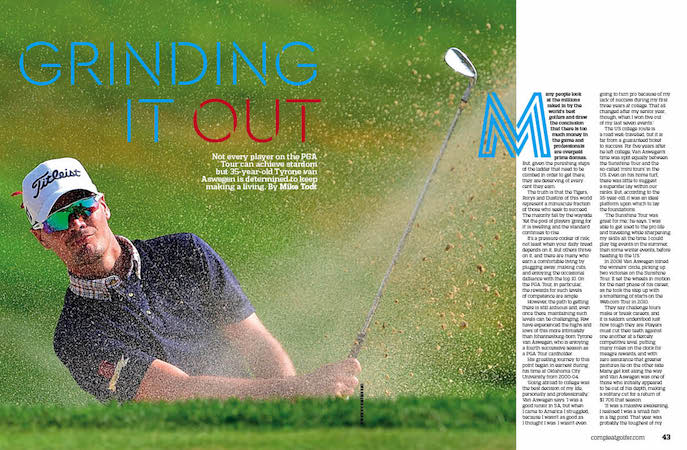Not every player on the PGA Tour can achieve stardom but 35-year-old Tyrone van Aswegen is determined to keep making a living, writes MIKE TODT.
Many people look at the millions raked in by the world’s best golfers and draw the conclusion that there is too much money in the game and professionals are overpaid prima donnas. But, given the punishing steps of the ladder that need to be climbed in order to get there, they are deserving of every cent they earn.
The truth is that the Tigers, Rorys and Dustins of this world represent a minuscule fraction of those who seek to succeed. The majority fall by the wayside. Yet the pool of players ‘going for it’ is swelling and the standard continues to rise.
It’s a pressure cooker of risk; not least when your daily bread depends on it. But others thrive on it, and there are many who earn a comfortable living by plugging away, making cuts, and enjoying the occasional dalliance with the top 10. On the PGA Tour, in particular, the rewards for such levels of competence are ample.
However, the path to getting there is still arduous and, even once there, maintaining such levels can be challenging. Few have experienced the highs and lows of this more intimately than Johannesburg-born Tyrone van Aswegen, who is enjoying a fourth successive season as a PGA Tour cardholder.
His gruelling journey to this point began in earnest during his time at Oklahoma City University from 2000-04.
‘Going abroad to college was the best decision of my life, personally and professionally,’ Van Aswegen says. ‘I was a good junior in SA, but when I came to America I struggled, because I wasn’t as good as I thought I was. I wasn’t even going to turn pro because of my lack of success during my first three years at college. That all changed after my senior year, though, when I won five outof my last seven events.’
The US college route is a road well-travelled, but it is far from a guaranteed ticket to success. For five years after he left college, Van Aswegen’s time was split equally between the Sunshine Tour and the so-called ‘mini tours’ in the US. Even on his home turf, there was little to suggest a superstar lay within our ranks. But, according to the 35-year-old, it was an ideal platform upon which to lay the foundations.
‘The Sunshine Tour was great for me,’ he says. ‘I was able to get used to the pro life and travelling while sharpening my skills all the time. I could play big events in the summer, then some winter events, before heading to the US.’
In 2008 Van Aswegen joined the winners’ circle, picking up two victories on the Sunshine Tour. It set the wheels in motion for the next phase of his career, as he took the step up with a smattering of starts on the Web.com Tour in 2010.
They say challenge tours make or break careers, and it is seldom understood just how tough they are. Players must cut their teeth against one another at a fiercely competitive level, putting many miles on the clock for meagre rewards, and with zero assurance that greener pastures lie on the other side. Many get lost along the way and Van Aswegen was one of those who initially appeared to be out of his depth, making a solitary cut for a return of $1 706 that season.
‘It was a massive awakening. I realised I was a small fish in a big pond. That year was probably the toughest of my golf career. I had a low status on the Web.com Tour, which meant I didn’t get many starts, and in the starts I did get, I played terribly. At the end of 2010 I started working with Robert Baker, who helped me get my full Web.com card for the 2011 season. Even then I wasn’t good enough – there are so many quality golfers trying to do the same thing. It took me three years to figure things out.’
Things improved considerably under Baker’s guidance, as Van Aswegen made just short of $150 000 in 2012 and 2013 on the Web.com Tour. It culminated in him securing a PGA Tour card for the 2014 season via the Web.com Finals. His tale of how events unfolded in securing that coveted card underlines just how fine the line is between unbridled joy and crushing disappointment.
‘It was the best day of my career up to that point,’ the Dallas resident says. ‘I was in a position to win the third playoff event, but with a few holes left I started getting bad breaks, and then I started thinking about it too much! But I managed to get up and down from a short-side bunker on the 18th; holed a five-footer left to right. I was so nervous I couldn’t even hold the putter properly. It’s really special because it was a dream, obviously, but there was also a lot of failure along the way.’
His life’s work had been dedicated to reaching this point and now his chance to join the world’s elite had arrived. But yet again, it was two steps forward, one back. Van Aswegen toiled in his first season, making nine out of 25 cuts. His finish at 144th in the FedExCup standings wasn’t enough for him to retain his card, although he would regain it via the Web.com Finals that September.
His second crack at the PGA Tour was even more of a grind. He made 12 out of 20 cuts that season. Unfortunately, an inability to drive it home over the weekend saw him finish in the top 25 just once, and he concluded his FedExCup campaign in 191st. However, in the unbearable cauldron of the Web.com playoffs, he once again came good and, in quite extraordinary circumstances, regained his card for 2016.
‘The first year was such a learning experience,’ he recalls. ‘New, tougher courses, new cities, superstars from all those years watching golf on TV. You’re going up against guys who play these courses year in and year out, and know their games better than you do. I don’t think the players are much better on the PGA Tour compared to the Web. The difference is the top players know their games inside out.’
He adds: ‘There are miracles along the way, of course, and one of them was when I got my PGA Tour card back in the most recent Finals [2015]. I needed a top-10 in the last event to get my card, although a missed cut meant only conditional status on the Web.com the next year. Talk about pressure!
‘On the 70th hole of the tournament I started leaking oil. I just needed to par in and I’d be safe. It was a par five with water all the way down the left. I blocked my tee shot right into the rough and had a bad lie. I hacked my lay-up down the right rough again into an even thicker lie and then chopped it out to about 40 yards from the pin. I said to my caddie, “I can’t believe this is happening right now.” All he said was, “Nothing has happened yet.” I proceeded to hole the pitch shot! Miracle. When I parred 18 I couldn’t believe it.’
This rollercoaster of emotions epitomises the daily struggles the likes of Van Aswegen – and caddie Jeff Johnson, his bagman for seven years – have endured. Fortunately, the duo have been able to breathe easier in the 18 months since, as Van Aswegen amassed in excess of $1-million in 2016 to secure his card. He is also already halfway there in 2017, having accumulated almost $500 000, and, as at the beginning of May, sat comfortably on the fringe of the top 100 in the FedExCup.
But even this upturn in fortunes has hardly been the result of scintillating finishes, or flirtation with victory. His best finish to date was a tie for third at last season’s Frys.com Open, while there have only been three others inside the top 10. Instead, the recipe for prosperity has been a relentless ability to make cuts; two-thirds of them, in fact, in all starts over the past two years.
So, does this level of consistency without triumph anoint Van Aswegen as the classic journeyman? Someone who finds himself at the limit of his ability and who must rely on narrowly finishing on the right side of the Bell Curve to make his way?
‘I don’t consider myself a journeyman,’ he counters.
‘Not yet, anyway. There is always pressure until you win a tournament, and even then there are different levels of pressure. The competition is just so good that if your game is average that week, you’ll probably be lucky to make the cut. The key is to get hot and make sure you capitalise on it. The first goal is to keep my card, but the second goal is to win, and I have no doubt I can do that. And as we say out here, great play takes care of most things.’
One thing is certain, though: having charted the most demanding of routes to reach the top level of the game, Van Aswegen is battle-hardened in the extreme. It should also be kept in mind that even if you wish to prematurely tag him as a lifelong journeyman, he’s still one of the 250 best golfers in the world. In any profession, that makes him an unqualified success.
BEST FINISHES
2006 – Dimension Data Pro-Am (2nd), Telkom PGA Championship (T4th)
2007 – Dimension Data Pro-Am (T5th)
2008 – Vodacom Origins of Golf – Pretoria (1st),Nedbank Affinity Cup (1st)
2009 – Soboba Classic (T3rd), Nashua Masters (T3rd), Joburg Open (T4th)
2010 – Dimension Data Pro-Am (T4th)
2012 – Lion of Africa Cape Town Open (T2nd), Mexico Open (T4th)
2013 – Nationwide Children’s Hospital Championship (T4th)
2014 – Byron Nelson Championship (T16th)
2015 – Frys.com Open (T3rd), Web.com Tour Championship (T5th)
2016 – Travelers Championship (T5th), CIMB Classic (T7th), Phoenix Open (T17th)
– This article first appeared in the May issue of Compleat Golfer







